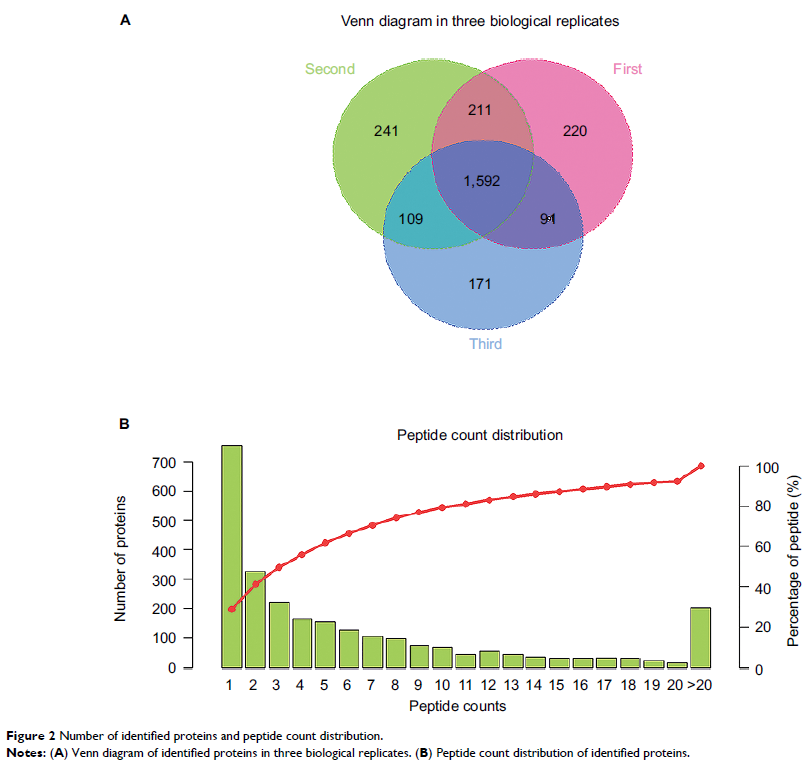9 1 1 5 0
论文已发表
注册即可获取德孚的最新动态
IF 收录期刊
- 2.6 Breast Cancer (Dove Med Press)
- 3.9 Clin Epidemiol
- 3.3 Cancer Manag Res
- 3.9 Infect Drug Resist
- 3.6 Clin Interv Aging
- 4.8 Drug Des Dev Ther
- 2.8 Int J Chronic Obstr
- 8.0 Int J Nanomed
- 2.3 Int J Women's Health
- 3.2 Neuropsych Dis Treat
- 4.0 OncoTargets Ther
- 2.2 Patient Prefer Adher
- 2.8 Ther Clin Risk Manag
- 2.7 J Pain Res
- 3.3 Diabet Metab Synd Ob
- 4.3 Psychol Res Behav Ma
- 3.4 Nat Sci Sleep
- 1.9 Pharmgenomics Pers Med
- 3.5 Risk Manag Healthc Policy
- 4.5 J Inflamm Res
- 2.3 Int J Gen Med
- 4.1 J Hepatocell Carcinoma
- 3.2 J Asthma Allergy
- 2.3 Clin Cosmet Investig Dermatol
- 3.3 J Multidiscip Healthc

定量蛋白质组学分析,以确定肌筋膜触发点大鼠模型中慢性肌筋膜疼痛的生物标志物和干针疗法的治疗靶点
Authors Li L, Huang Q, Barbero M, Liu L, Nguyen T, Beretta-Piccoli M, Xu A, Ji L
Received 4 September 2018
Accepted for publication 12 November 2018
Published 7 January 2019 Volume 2019:12 Pages 283—298
DOI https://doi.org/10.2147/JPR.S185916
Checked for plagiarism Yes
Review by Single-blind
Peer reviewers approved by Dr Cristina Weinberg
Peer reviewer comments 3
Editor who approved publication: Dr Michael Ueberall
Background: Proteomics
analysis may provide important information regarding the pathogenesis of
chronic myofascial pain and the mechanisms underlying the treatment effects of
dry needling.
Materials and methods: This study used
a rat model of myofascial trigger points (MTrPs) to perform a proteomics
analysis. Three biological replicate experiments were used to compare the
proteomes of healthy control rats, a rat model of MTrP, MTrP model rats
following dry needling of MTrPs, and MTrP model rats following dry needling of
non-MTrPs. Tandem mass tag (TMT) labeling technology based on nanoscale liquid
chromatography-tandem mass spectrometry was used. Hierarchical clustering, gene
ontology (GO) analysis, Kyoto Encyclopedia of Genes and Genomes (KEGG)
analysis, and protein–protein interaction network analysis were performed to
characterize the proteins. To validate the TMT results, three candidate
biomarker proteins were verified using parallel reaction monitoring and Western
blot analysis.
Results: A total of
2,635 proteins were identified. GO and KEGG enrichment analyses showed that the
glycolysis/gluconeogenesis pathways played dominant roles in the pathogenesis
of chronic myofascial pain. The three candidate biomarker proteins were the
pyruvate kinase muscle isozyme (encoded by the PKM gene), the
muscle isoform of glycogen phosphorylase (encoded by the PYGM gene),
and myozenin 2 (encoded by the MYOZ2 gene). The validation results were
consistent with the TMT results.
Conclusion: This is
the first proteomics study that has investigated the pathogenesis of chronic
myofascial pain and the mechanisms underlying the treatment effects of dry
needling in an in vivo rat model of MTrPs, which might promote our
understanding of the molecular mechanisms underlying chronic myofascial pain.
Keywords: musculoskeletal
pain, acupuncture, bioinformatics, mass spectrometry, tandem mass tag, parallel
reaction monitoring
